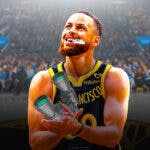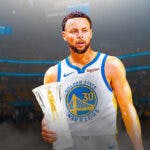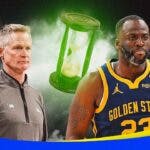When it comes to the criticism Golden State faces, generally it’s a form of nit-picking. The Bay-Area boys employ two of the league’s three best players, a top ten shooter of all time and Draymond Green. Yet, for some reason, this criticism seems different. Poor performance over the past several days starts highlighting a genuine concern that isn’t just related to a slump.
The Golden State bench composition is showing objective flaws and General Manager Bob Myers didn’t make any moves before the deadline.
With Jordan Bell still indefinitely side-lined, Myers may have to change his stance that, “the cohesiveness of our team matters to us and the continuity matters to us.” Luckily for Myers, a solution might just manifest itself over the next few weeks.
Let’s first pinpoint the bench’s primary issues. On the defensive end, Jordan Bell’s absence is felt throughout. His position as a free safety defender (called to play help defender on any position) mimics Draymond’s defensive chops. The result watches Patrick McCaw getting blown by and no help defense stepping in. In general, the Warriors compensate extremely well on defense for any defensive disadvantages. However, the real issues on the second unit aren’t defensive chops.

Shawn Livingston is a solid on-ball defender. David West might be somewhere around 85 years old but he’s still a relatively mobile center. Omri Casspi billed himself as a 3-and-D specialist (but more on that later). In actuality, there are two main issues facing the Golden State second unit: (1) A lack of self-manufactured offense. And (2) Poor second unit spacing. Let’s address these one at a time.
Stagnation on the offensive end primarily stems from a lack of creation. Creation stems from a point guard finding the open man, a shooter drawing the defense or just beating your man one-on-one. Golden State’s bench can’t effectively and consistently assemble offensive sets which achieve any semblance of these actions. In essence, Golden State’s bench can do everything for the Warriors until they have to find their own shots.

Andre Iguodala is taking a career-low five shots per game and making a career-low 23% of his threes (once again more on that later). Patrick McCaw plays with hesitation. The only true produced offense stems from either a ten-foot turnaround jump shot from Shawn Livingston or a David West mid-range jump shot. With those the primary consistent threats, defenders find it easy to double team and exploit those options. It’s possible then to argue that this lack of offensive creation isn’t then a product of ability but rather that a lack of spacing limits the clean looks those truly consistent offensive options get.
With the League’s increased pace, spacing has become crucial to any offensive scheme. With more and more buckets coming from transition plays, a strong three-point shooting threat on the wing prevents defenses from clogging the paint on a drive.

Similarly, from a set play, defenders tend to gravitate towards the ball handler or play-maker when their man isn’t a strong three-point shooter (watch anyone guard Andre Robertson for an example of this). The Warriors’ second unit has neither of these. Let’s quickly run down the current three-point shooting situation. Starting with Livingston, I’d like to cite my own research on backup point guards I compiled last year:
“Excluding Livingston, whose 0% three-point shooting results from never taking a shot”
That’s correct. Livingston has taken almost no three-point shots from the backup point guard position in his entire career. Not to dismiss what he is good at, his high-level defensive chops and mid-range game provide an excellent foil to Curry’s volume shooting. That said, he’s no threat to pull up from the key or get a swing pass from a driving man.

David West isn’t a three-point shooter either. Omri Casspi has taken a total of nine three-point attempts this year. That leaves Nick “Swaggy P” Young. Young’s consistency issues alone make him a problem. On a night to night basis, opposing teams can simply wait out the first quarter to find out if their defence needs to adjust to Young. Simply put, the Warriors’ second unit lacks a true creator on the wings that can serve as a three-point threat. Luckily for them, a buyout candidate that fits the bill might just become available.
It’s Joe Johnson. I’m talking about Joe Johnson. Though dwindling into the twilight of his career, Johnson provided energy and shot-making in limited minutes for the Utah Jazz. As The Ringer writer Jonathan Tjarks puts it in his scouting report:
“There’s nothing too complicated about the way Johnson plays. He has the size and ballhandling ability to carve out space against almost any defender, and he’s an elite off-the-dribble shooter.”

This season Johnson is averaging eight points a game in 20 minutes. His three point shooting this year has significantly declined, down from a career 38% average (The league average sits somewhere around 37, adjusted for non-shooters and outliers it drops closer to 34%), however, there’s reason to believe that running Johnson for closer to 15 minutes a game would keep his body fresh and increase percentages.
Johnson fits the bill for both issues the Warriors’ second unit is suffering from. Nicknamed Iso-Joe back in his prime, Johnson’s ability to create in the one-on-one and beat out opponents on isolation spot up jumpers became his bread and butter.

That shooting carried over, with significant three-point threat on the wing. Johnson can play either role, Livingston feeding him the ball and running an isolation threat against a team’s second unit defenders or waiting on the wings for a pass from a driving guard or big. In either situation Johnson attracts the gravity of the defense, cleaning up the potential looks Livingston and West get on offense. Additionally, it should be noted that Johnson’s relatively quiet personality does mesh well with a low interference model that Bob Myers might look to foster within the Championship locker-room.
With Houston, Boston, Oklahoma City and others nipping at the heels, The Golden State Warriors are going to have to make quite the pitch to beat out these other Western Conference juggernauts (a sentence I wasn’t expecting to type this year). Just like the Rockets and Thunder, Golden State will promise a ring. The real question is even with Johnson could they convert that promise into reality?
Unless otherwise noted, all statistics courtesy of Basketball-Reference.com




